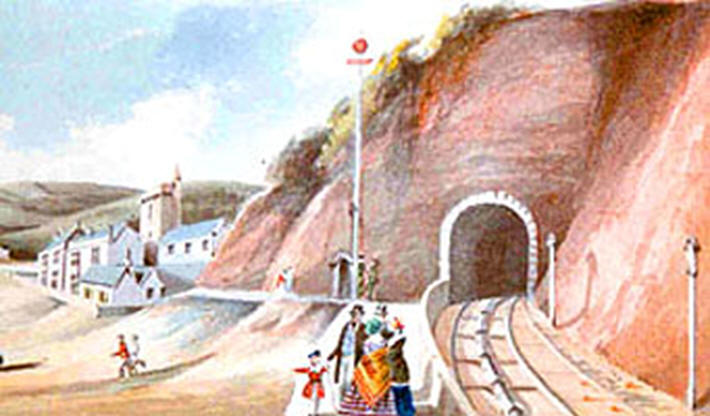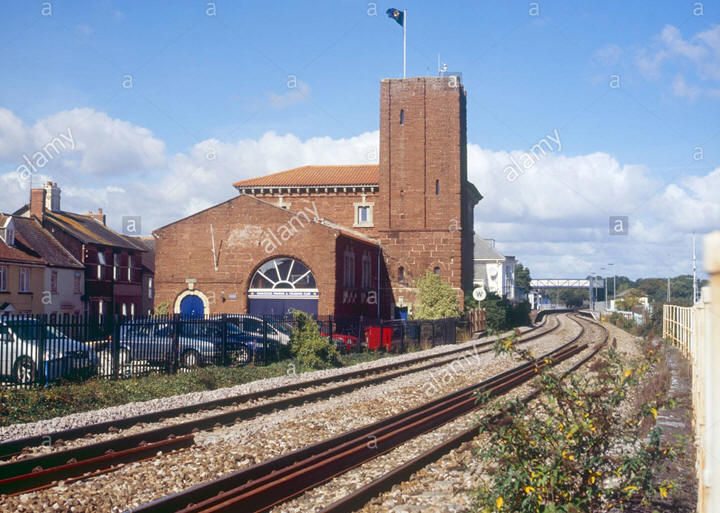GREAT KENT ATMOSPHERIC RAILWAY - 1845
An atmospheric railway uses differential air pressure to provide power for propulsion of a railway vehicle. A series of trackside power sources transmits motive power to the vehicle, circumventing the necessity of carrying mobile power generating equipment.
The air pressure, or partial vacuum can be conveyed to the vehicle in a continuous pipe, where the vehicle carries a piston running in the tube. Some form of re-sealable slot is required to enable the piston to be attached to the vehicle. Alternatively the entire vehicle may act as the piston in a large tube, which is known s a pneumatic railway.
Several variants of the principle were proposed in the early 19th century, and a number of practical forms were implemented, see the panel to the right. However all were overcome with unforeseen disadvantages and discontinued within a few years.
Great Kent Atmospheric Railway
This early railway proposal dates from 1845. At that time the South Eastern Railway main line to Dover was nearing completion. However the route taken, south from London Bridge to Redhill, then due east to Tonbridge, was quite indirect, and neglected all the towns in the local area, notably Bromley and Sevenoaks.This proposal aimed to rectify this by taking a direct route, thereby anticipating the eventual main lines that would not be completed for a further twenty years or so.
Notably this proposal was for an atmospheric railway, building on what at the time were thought to be favourable trials carried out elsewhere, see the panel to the right.
The line was to branch off of the existing, and at the time the only, main line south from London Bridge toward Brighton. But instead of using a junction as far south as Redhill, as was the case with the then new South Eastern Railway line, the junction was to be made much nearer to London in the New Cross area. The line would then proceed south-east toward Bromley, passing Plaistow, then a village near to Grove Park.
|
|
|
Beyond Bromley the line would pass Bromley Common, and cross Crofton Road at what is called Brasted, a name that has now died out but is at Locksbottom.
|
|
|
It would then pass through the centre of Farnborough Village, necessitating a slight diversion to the end of Tubbenden Lane, and onward to Green Street Green and Pratts Bottom (on the map called 'Spratts Bottom'), necessitation a minor diversion of Hastings Road.
|
|
|
Once beyond Polehill the line would divide, one line going to Maidstone, and one onward to Canturbury and the coast.
Given the extensive nature of the proposal, the challenging terrain to be overcome, and the unproven use of this motive technology on this scale it is hardly surprising that it did not get approved by parliament.
The scheme was abandoned, but not before The Railway Times published this surprisingly critical article about the proposal on 11th July 1846. It does not seem to have been based solely on an assessment of the technology...
The context was that when the South Eastern Railway were planning their route eastward from Tonbridge toward Dover they initially met fierce opposition from the powers that be in Maidstone, which is why the line goes via Paddock Wood, with just a branch to Maidstone.
The South Eastern Railway line to Maidstone West via Paddock Wood opened in September 1844. A second station Maidstone East, on a different line offering a more direct service to London, was opened by the London Chatham and Dover Railway in June 1874.
Commentary by 'The Railway Times'
Gratitude is as bright a virtue as any which adorns the human character,
and there are few who do not delight in witnessing its exhibition; and
on the other hand ingratitude is as foul a stain upon the human heart as
any which can be impressive there.There was a time when the people of Maidstone declared that the South Eastern Railway would not near their town; and so violent was their opposition that the Dover line was carried far away from them. When however the railway was opposed they of course discovered the error which they had committed, and they humbly supplicated the South Eastern Railway to give them a branch line, The line was generously conceded to them and great was the delight of the inhabitants of Maidstone when the railway was completed and opened. Mark how long their gratitude was!
The South Eastern proposed to give them a direct line to the Metropolis, and application is made to the Legislature for powers to so do. The mania in the railway world however has in the meantime called into existence a miserable and impracticable scheme called the Great Kent Atmospheric Railway. A more miserable abortion was never thrust before the public, and the Committee of the House of Commons unanimously threw it out. Of course the new company was liberal in promises which they knew they could never perform, and a few of the Maidstone people were caught by the dangerous glitter, and were induced to give it their support.
Since the unanimous rejection of the Kent Atmospheric bubble a petition has been presented to the House of Lords, declaring that the proposed direct line will cost so much and the accommodation which it will afford will not justify such expenditure and the petition concluded with a prayer of course; and what a prayer? Why,not simply that the South-Eastern Bill should be thrown out, but that the Great Kent Atmospheric should be passed - next year.
Now is this not really trifling with the Legislation? We unhesitantly declare that it is impossible to construct the Great Kent Atmospheric line as sought in this session. It is a line that was never meant to be made; and a few people in Maidstone, certainly not the majority, have allowed themselve to be led by the nose by those who have concocted this scheme.
Some people in Maidstone have been led away with the idea that the Kent Atmospheric Railway would carry cheaper than the South Eastern company. The Kent Atmospheric people have promised so much, and some of the people of Maidstone have given them credit for sincerity. Why, they might have promised anything, for they felt themselves that they never would be in a position to be called upon to perform their promises. We know that before the Kent Atmospheric Bill went before the Committee, one of its promoters offered to make a bet of six to one that the Bill would not be granted. What could be the value of a promise from such people?
But the South Eastern Company themselves are amongst the most reasonable chargers in the Kingdom. Their third class trains are actually below the Government penny-a-mile train in point of charge, and above it in point of speed; and shall a promise from an un-fledged Company be allowed, for one moment, to weigh against the substantial claims of a company like the South Eastern? We assuredly feel that they would not. We look with confidence to the justice and impartiality of the House of Lords, and we will not be disappointed.
We have taken the matter up, not on account of the importance of the Great Kent Atmospheric Company as oppoosed to the South Eastern Company, but in order to point out to certain parties the danger they run in placing implicit reliance upon the promises of strangers.
The South Eastern Company have striven hard to give efficient accomodation to the county of Kent, and a heavy up-hill game they have to play. They have however been undismayed, and we hope, and confidently trust, that they will be amply rewarded .
We ask the people of Kent whether the South Eastern Company have ever broken a pledge which they have given? And this question being answered, in the affirmative, we call upon the inhabitants of Kent to vindicate themselves and award justice to those who have endeavoured, and with success, to benefit and accommodate them.
The Railway Times July 1846
EARLY DAYS
Other Atmospheric Railways
London and Croydon Railway
The line from London Bridge initially used just steam power, but congestion on the heavily used line at the London end led to the installation of a third, atmospheric, line alongside, which opened in 1844.Despite initial favourable reports the hot summer of 1846 caused considerable difficulties through leather flaps drying out.
The board lost confidence in the technology and the system was replaced by conventional motive power during 1847.

System pipe in Croydon museum
South Devon Railway.
The Great Western Railway (GWR) and the Bristol and Exeter Railway working collaboratively had reached Exeter on 1 May 1844, with a broad gauge railway connecting the city to London.Interested parties in Devonshire considered it important to extend the connection to Plymouth, but the terrain posed considerable difficulties: there was high ground with no easy route through.
The Company's engineer was the innovative Isambard Kingdom Brunel. He had visited the Dalkey line in Ireland and had been impressed with the capabilities of the atmospheric system on that line. The claimed advantages included much better hill climbing abilities and lighter weight on the track. This would enable a line in hilly terrain to be planned with steeper than usual gradients, saving substantial cost of construction.

Construction started at once, and a train service started between Exeter and Teignmouth on 30 May 1846, but this was operated by steam engines, hired in from the GWR. At length, on 13 September 1847 the first passenger trains started operating on the atmospheric system. Through that winter of 1847-8 a regular service was maintained to Teignmouth But the leather flap valve that sealed the traction pipe slot began to give trouble. In the following spring and summer, there was hot and dry weather causing further problems, also sections of the flap tore away from its fixing, and had to be quickly replaced.
With a contractual impasse during struggles to keep a flawed system in operation, and very expensive overhaul costs looming, it was inevitable that the end was near.

At a shareholders' meeting on 29 August 1848, the directors were obliged to report all the difficulties, and that Brunel had advised abandonment of the atmospheric system. Huge hostility was generated among some shareholders, and Brunel in particular was heavily criticised, but the atmospheric system on the line was finished.


